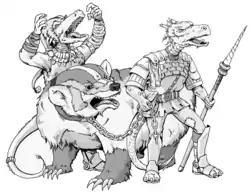Kobold (Dungeons & Dragons)
Kobolds are a fictional race of humanoid creatures, featured in the Dungeons & Dragons roleplaying game and other fantasy media. They are generally depicted as small reptilian humanoids with long tails, distantly related to dragons.
| Kobold | |
|---|---|
 An illustration of two kobolds | |
| First appearance | Dungeons & Dragons (1974) |
| Based on | Goblin |
| Information | |
| Type | Humanoid |
| Alignment | Usually Lawful Evil |
In fantasy roleplaying games, kobolds are often used as weak "cannon fodder" monsters, similar to goblins, but may be cunning and strong in groups.[1][2]
Depictions
In Dungeons & Dragons
Kobolds appeared as monsters alongside goblins, orcs, and trolls in the 1971 wargame Chainmail, as part of Gary Gygax's "fantasy supplement" inspired by The Hobbit and other fantasy novels.[3] This supplement inspired the first editions of Dungeons & Dragons (1974), where kobolds appear again.[4] In these early appearances, they are only described as creatures similar to goblins.
Kobolds were first depicted as doglike reptilian humanoids in Gygax's Monster Manual (1977) for Advanced Dungeons & Dragons (AD&D), which describes them as aggressive, tribal creatures living in dark forests or subterranean settings.[5]
In 1987, Roger E. Moore published the editorial "Tucker's kobolds" in the magazine Dragon, describing a game scenario where a horde of well-prepared kobolds uses guerrilla tactics to significantly challenge a far more powerful party of adventurers.[6] This editorial became popular among roleplaying fans, and helped kobolds gain traction.[7]
Later editions of the game emphasized their draconic aspects, and suggest that kobolds are biologically related to dragons, and view them as an object of worship and servitude.[8] The AD&D 2nd Edition Monstrous Manual (1993) introduced Urds, a race similar to kobolds with batlike wings.[9] In the 3rd edition, urds were seemingly replaced by dragonwrought kobolds, a subrace of kobolds with more prominent draconic features such as wings.
Reception
Screen Rant compiled a list of the game's "10 Most Powerful (And 10 Weakest) Monsters, Ranked" in 2018, calling this one of the weakest, saying "When a dungeon master has run several low-level Dungeons & Dragons adventures, they will inevitably grow weary of using the same creatures from before and will want to shake things up. That's the moment when they prepare to paint over the serial numbers and replace the goblins with kobolds."[10]
The kobold was considered one of the "five main "humanoid" races" in AD&D by Paul Karczag and Lawrence Schick.[11]
Journalist David M. Ewalt highlighted that kobolds have often been the first combat encounter for new players of Dungeons & Dragons, from its beginnings to the current 5th edition.[12]
References
- Hoffer, Christian (2020-02-06). "Every Dungeons & Dragons Campaign Should Include Kobolds". ComicBook.
- "13 Most Powerful D&D Monsters (And 12 Weakest)". CBR. 2018-10-10. Retrieved 2021-01-06.
- Gygax, Gary; Peren, Jeff (1972). Chainmail: Rules for Medieval Miniatures (PDF) (2nd ed.). Guidon Games. pp. 25–32.
[W]e are including a brief set of rules which will allow the medieval miniatures wargamer to [...] refight the epic struggles related by J. R. R. Tolkien, Robert E. Howard, and other fantasy writers.
- Gygax, Gary; Arneson, Dave (1974). Dungeons & Dragons: Single Volume Edition (PDF). Tactical Study Rules. p. 49.
Treat these monsters as if they were Goblins except that they will take [fewer attacks].
- Gygax, Gary (1979). Monster Manual (PDF). TSR Games. p. 58. ISBN 0-935696-00-8.
Kobolds are usually found in dank, dark places such as dismal overgrown forests or subterranean settings. [...] The hide of kabolds runs from very dark rusty brawn to a rusty black. They have no hair.
- Moore, Roger E (November 1987). "Tucker's Kobolds" (PDF). Dragon. No. #127. TSR.
- Caroll, Bart. "Excerpt: Kobold". Dungeons & Dragons. Wizards of the Coast.
- Kestrel, Gwendolyn F.M.; Wilkes, Jennifer Clarke; Liquette, Kolja Raven (2006). Races of the Dragon (PDF). Wizards of the Coast. p. 48. ISBN 0-7869-3913-3.
The body and soul of any kobold is dedicated to dragons, whether literally or figuratively. Kobolds search for the dragon in themselves, and they pledge themselves to the dragon in their rites of passage. In the presence of an actual dragon, kobolds are servile, doing anything required of them. Kobolds see dragons as older and wiser kin and cultural heroes.
- Stewart, Doug (1993). Monstrous Manual. TSR. p. 214. ISBN 1-5607-6619-0.
- "Dungeons & Dragons: 10 Most Powerful (And 10 Weakest) Monsters, Ranked". ScreenRant. May 20, 2018.
- Schick, Lawrence (1991). Heroic Worlds: A History and Guide to Role-Playing Games. Prometheus Books. p. 92. ISBN 0-87975-653-5.
- Ewalt, David M. (2013). Of Dice and Men: The Story of Dungeons & Dragons and the People Who Play It. Scribner. p. 109. ISBN 978-1-4516-4052-6.
Further reading
- Hergenrader, Trent (2019). Collaborative Worldbuilding for Writers and Gamers. Bloomsbury Academic. pp. 95–98. ISBN 978-1-3500-1667-5.
- Greenwood, Ed (1995). "Elminster's Notebook". Dragon. TSR. #216.
- Holian, Gary, Erik Mona, Sean K Reynolds, and Frederick Weining. Living Greyhawk Gazetteer. Renton, WA: Wizards of the Coast, 2000.
- Sargent, Carl. Monster Mythology. Lake Geneva, WI: TSR, 1992.